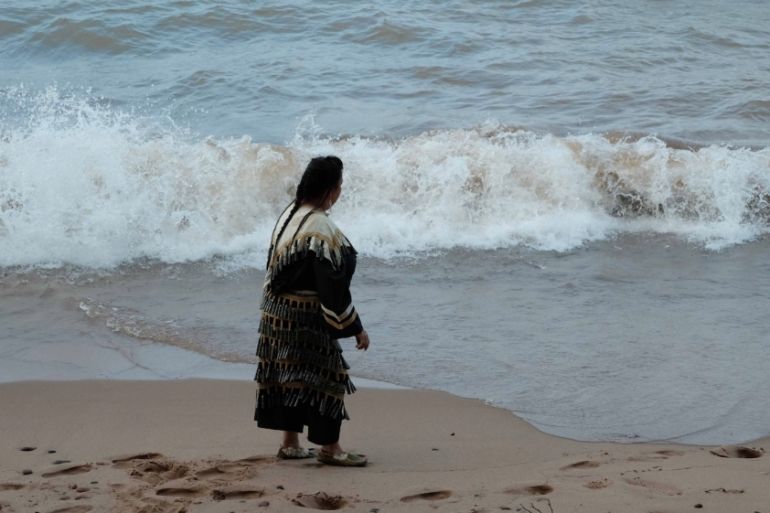‘Our feet grow into the ground’: The Ojibwe women owning the shore
How a Native American tribe reclaimed the land they once sacrificed in exchange for their physical survival.

On Mooningwaanikaaning (the place of the yellow-breasted flicker birds) Madeline Island, Wisconsin – along the shore of Gichigami (the great sea) Lake Superior – Katherine Morrisseau of the Red Cliff Band of Ojibwe dances in her zibaaska’iganagooday (dress of exploding sound), or jingle dress.
For me, an enrolled citizen of the Red Cliff Ojibwe Reservation, this moment preserved on film is a powerful emblem of Ojibwe resistance and resilience and the essential role that women play in our survivance in the face of centuries of colonisation and suppression.
Keep reading
list of 4 itemsIndigenous people in Philippines’s north ‘ready to fight’ as tensions rise
Curfew announced for under-18s in Australia’s Alice Springs after unrest
‘We exist’: A Himayalan hamlet, forgotten by Indian democracy
Well-known Ojibwe activist Winona LaDuke has described Mooningwaanikaaning or Madeline Island, the largest of Lake Superior’s Apostle Islands, as a kind of Jerusalem for Ojibwe people.
As told in oral tradition, Ojibwe migrated to the Great Lakes region from lands near present-day Nova Scotia over 800 years ago. It is said that the people chose to settle where “the food grows on the water”, a reference to manoomin or wild rice, a staple good that grows abundantly in the lake sloughs and rivers in the region. It was here on the northern shore of Madeline Island – now called Amnicon Bay – that those early immigrants conducted the first dance of the Grand Medicine Society, one of the most important Ojibwe ceremonies.
In the Treaty of 1854 – in which the great chief and diplomat Bezhike (Buffalo) ensured that Ojibwe would remain in their ancestral homelands in exchange for lands ceded to the United States – the 81-hectare (200-acre) Amnicon Bay shoreline was included in lands set aside for the Bad River Reservation located about 90 kilometres (35 miles) away on the Wisconsin mainland.
But the Bad River tribe struggled for physical survival on the reservation, where land for hunting, fishing and gathering was limited, there were no jobs, and access to transportation, healthcare and food was miles away.
So the tribe was forced to sacrifice Amnicon Bay in the form of a lease to wealthy white vacation cabin owners. In 1967, the tribe agreed to a 50-year lease of the shorelands for an initial annual payment of $5,000.
“Back in 1967, the tribe was broke; even a thousand dollars coming in was a lot of money,” said Edith Leoso, Bad River Tribal Historic Preservation officer.
“People weren’t happy about it but we knew it was temporary; one day we would take the land back,” she said.
An old story
It is an old story in Indian country: Sacrifice of dearest cultural possessions in exchange for physical survival.
As years went on and Madeline Island became more popular with wealthy vacationers, Ojibwe connection to their beloved Mooningwaanikaaning grew more tenuous.
According to a study by the Minnesota Department of Natural Resources, the average tourist visiting the Apostle Islands area is overwhelmingly white, well-educated, with an income of more than $100,000. Meanwhile, most folks from Bad River hover near the federal poverty line; most people do not go on to college.
The $39 roundtrip ferry ride from the mainland to the island was the final straw, effectively cutting Ojibwe off from one of their most sacred sites.
In 2017, after hearing that Bad River people were considering cancelling the lease renewal, I visited the Amnicon Bay cabin owners. Several of the 18 cabins were beautifully built and well-appointed. It was pretty clear the owners did not see much likelihood that Bad River would decide to cancel a lease that had paid the tribe more than $2m over the past 50 years.
When I mentioned to cabin owner Peggy Swarz that Bad River people did not feel welcome on the island or at Amnicon Bay she said: “It’s not as though our paths normally cross; we’re not friends. This is a resort area, it’s understandable that they don’t feel comfortable here.”
Swarz and other cabin owners also mentioned several past incidents between Native and non-Native people on the Bay. Once, a belligerent cabin owner ordered Bad River tribal members engaged in a sweat lodge ceremony to leave the leased land; another time white people confronted tribal members trying to pray along the shore.
‘Dancing and telling our stories’
Visiting Mooningwaanikaaning is one of my private acts of resistance. Making my way past the souvenir and t-shirt shops, I have stubbornly offered up prayers at Amnicon Bay for years.
So, it came with great personal satisfaction when I learned that the Bad River tribe chose not to renew the Amnicon Bay lease. I heard that those cabin owners unceremoniously handed the keys of their fancy cabins over to Bad River tribal members and simply walked away. I would have given anything to see the looks on the faces of those entitled vacationers, but was unable to witness their delicious denouement.
I did, however, get to see and photograph Morrisseau in 2018 dancing along the shore in her jingle dress. She and others were staying in the cabins while conducting a workshop for Native youth.
An Ojibwe woman dancing in her jingle dress is believed to have great healing powers. And it is women who play a central role in promoting the Ojibwe world view in which spirituality is the bedrock for life.
That day, Morrisseau danced leisurely along that shore as though she owned it. There was no one to shoo her away.
“For Ojibwe women, our feet grow right into the ground here on Mooningwaanikaaning; we’re here dancing and telling our stories again,” she said.